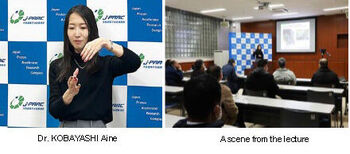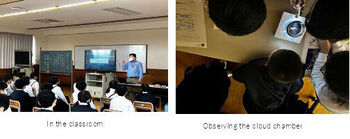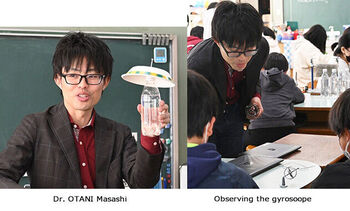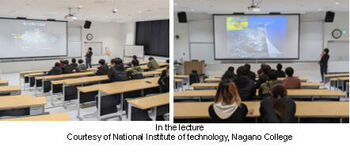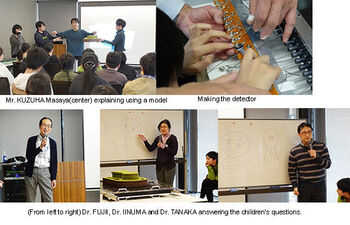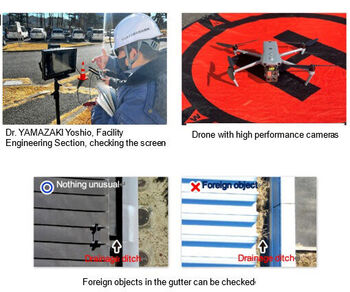J-PARC News February 2025 (Issue #238)
■Winning an award
The 14th (FY2024) Nishikawa Prize for Encouragement of the Foundation for High Energy Accelerator Science.
Dr. TOMIZAWA Masahito of the Accelerator Section Ⅵ received the Nishikawa Prize, one of the incentive awards of the Foundation for High Energy Accelerator Science.
This award was established in honor of Dr. NISHIKAWA Tetsuji, who has made great achievements in research fields related to accelerator science. This prize is awarded to one or more researchers or engineers who have achieved outstanding originality and internationally acclaimed achievements in basic experimental or theoretical research and applied research related to high-energy accelerators.
This award relates to research on improving the performance of slow extraction operations in the J-PARC main ring (MR).
Dr. TOMIZAWA was responsible for the slow extraction of the J-PARC MR and was engaged in the beam optics design based on detailed beam dynamics studies, hardware R&D, construction of the actual machine, practical operation, and achieving the world's highest performance extraction efficiency of 99.6%.
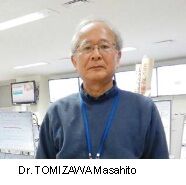
■Water-containing, humidity-responsive lamellar structured polymer materials
- Self-assembly of superabsorbent polymers with their unique properties- (February 17th).
Sodium acrylate (ANa) is a raw material for superabsorbent polymers used in products such as disposable diapers. Inspired by its characteristics, it was conceived that designing an amphiphilic random copolymer containing ANa and hydrophobic alkyl groups would allow the polymer material to form a microphase-separated structure by absorbing water from the environment.
In this study, we synthesized a random copolymer of ANa and hydrophobic dodecyl acrylate and subjected it to water vapor annealing for 12 hours. Small-angle X-ray scattering (SAXS) measurements revealed the formation of a lamellar microphase-separated structure with alternating hydrophilic layers containing water and hydrophobic layers. Furthermore, neutron reflectivity (NR) measurements at J-PARC and observations using atomic force microscopy (AFM) have revealed the processes of the lamellar structure formation in response to increasing humidity and the absorption of water into the hydrophilic layer of the lamellar structure.
In the future, we expect applications in functional materials utilizing the hydrophilic layers containing water and phase-separated structures. In addition, by integrating this technology with degradable polymers and other materials, the development of self-assembling materials with both recyclability and resource recycling properties will be promoted.
■J-PARC Hello Science
‘The World of Accelerator High Intensity Beams’ (January 31st)
The lecturer, Dr. KOBAYASHI Aine from the Accelerator Division, is involved in the upgrade of MR, the largest accelerator at J-PARC. After obtaining her PhD in particle physics, Dr. KOBAYASHIi became interested in accelerators that produce elementary particles and is currently working on solving the problem of beam loss in high-intensity proton beams.
Beam loss is the loss of a beam as it travels. As well as reducing the number of proton beams, which are among the strongest in the world, it has the detrimental effect of causing equipment failures and radiation, making it impossible to increase the intensity of the beam. Among the events that cause beam loss is beam instability, where collective oscillations of the bunch, which is particularly problematic for high-intensity beams. This is caused by the electromagnetic interaction between the beam and the structure of the device, so it is necessary to understand the mechanism and take countermeasures to suppress the oscillations by kicking the beam with a feedback device.
It was also introduced that in the future, depending on the beam conditions, the vacuum may deteriorate due to the electron clouds, causing beam loss and further beam instability, and that countermeasures and studies against these are also being carried out.
■J-PARC Outreach Activities
(1) Tanaka Elementary School, Namekawa-City, Toyama (January 22nd).
Mr. TAKAHASHI Kazutoshi, Radiation Control Section, gave a lecture on the theme of “Small Secrets of Big Universe” to about 40 children in the fourth grade.
He gave a lecture about accelerators that aim for the edge of the small world. The children tried making a cloud chamber, a device that makes invisible radiation visible, and experienced the world of subatomic particles, the universe's little secrets.
(2) Ichige Elementary School, Hitachinaka City (January 31st)
Dr. OTANI Masashi of the Accelerator Section Ⅶ was the lecturer on the topic 'How to make a strange top that leans but doesn't fall over?‘ to about 80 children from two 6th grade classes at Ichige Elementary School.
Dr. OTANI explained elementary particle research at J-PARC using gyroscopes and self-assembled spinning tops. A top that continues to spin while tilted, and the axis of the top rotates with the top itself. This movement, known as precession, changes the direction of rotation of the axis when the center of gravity of the top is changed. Through the observation of the tops, we hope that the students have been able to sense the existence of subatomic particles.
(3) National Institute of Technology, Nagano College, Nagano Prefecture(January 27th)
Dr. OTANI Masashi from the Accelerator Division gave a lecture titled “How an accelerator works the microscopic world -muon acceleration technology to see through particle phenomena to giant structures-“ to about 20 students from grades 1 to 5.
The lecture began with an explanation of the principles of accelerators and followed by examples of their use, such as in medical applications. Next, the lecture covered elementary particles called muons, which have been used to discover hidden chambers in ancient pyramids and to image the interior of volcanoes. He then introduced research utilizing artificially produced high-intensity muons at J-PARC, as well as the latest technological developments and research advancements in this field.
(4) Katsuta Third Junior High School, Hitachinaka City (February 4th)
A lecture and workshop to build a “cloud chamber” was held for about 120 students in four ninth grade classes to deepen their understanding of basic knowledge related to space, energy and radiation.
First, Dr. KOBAYASHI Takashi, Director of the J-PARC Center, gave a lecture on the theme ‘Secrets of the Big Universe, Microscopic World and Accelerators’, in which he talked about the size of the universe and the smallness of the microscopic world, and also about the research being conducted at J-PARC on space, elementary particles and accelerators, sometimes based on his own experiences
Next, in the theme “How to ‘see’ small things” by Mr. TAKAHASHI Kazutoshi, Radiation Control Section, gave a presentation. The students challenged to make a “cloud chamber” through group work, which allowed alpha radiation to be visualized in supersaturated ethanol.
(5) Shirakata Elementary School, Tokai-Village (February 7th)
The ※MLF Outreach Circle ‘Protons’ gave classes and guided observations for approximately 80 students from three fourth-grade classes. The theme was ‘You are a researcher, too! Let's observe creatures of various sizes.’
With the slogan “The first step in research is to look closely!” the children challenged three themes: (1) dissecting dried sardines, (2) looking at the swimming masters, water fleas, and (3) the secrets of natto.
Observing the creatures around us with magnifying glasses and microscopes can lead to new discoveries. Dr. Shibazaki, the leader of this outreach class, sent a message to the students as below.
"It is important to think that science is fun! I would be happy if you include ‘researcher’ as your potential future career.”
※ MLF=Material and Life Science Experimental Facility
■Muographic Investigation of Ancient Burial Mounds in Tokai
The "Detector for History and the Future" reports on the status of data analysis and the construction of the second detector (February 16th)
The 9th activity of the year was held at the Tokai Village Museum, with 21 children in attendance. Before starting the production of the detector, Mr. KUZUHA of the Graduate School of Ibaraki University reported on the progress of data analysis of the “Detector for History and the Future” installed at Funatsuka No.2 Burial Mound on October 13th last year. He reported that “the outline of the burial mound is beginning to become visible,” raising hopes that the original goal of “finding a cavity (a tomb) inside the mound” might be achieved.
Making the detector was again delicate and nerve-wracking work, but after listening to the reports of the analysis results, everyone is more enthusiastic than ever to make an even better detector. In addition to Mr. KUZUHA, Dr. FUJII from J-PARC and Dr. IINUMA and Dr. TANAKA from Ibaraki University also took part in the children’s question corner.
Next time will finally be the last lecture of this fiscal year.
■J-PARC Sanpomichi 55 - Flying a drone at J-PARC facility inspections - 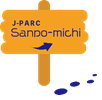
On February 14th, a drone flew over J-PARC in clear skies. Its purpose was to check the gutters of the Linac, RCS and MLF for any abnormalities. The gutters of these huge buildings are located under the eaves, and direct visual inspection requires careful, gradual movement with a lifeline, whether climbing from the ground or descending from the roof. Drone-based inspections eliminated the need for human intervention at height, and the high performance camera was able to zoom in, making it easy to observe the presence or absence of foreign objects. For example, we found that gutters facing the forest and those not facing the forest had completely different accumulations of pine needles and other debris. This information can be obtained in just one day's inspection, allowing repairs and other work to be carried out more efficiently in the future.
Modern image analysis can also use infrared light to capture images in the dark and monitor temperature distribution. Not only can this greatly improve the efficiency of facilities management, but it also provides accurate information that cannot be obtained visually and is expected to contribute to advanced diagnosis of abnormalities in facilities and equipment. The Facility Engineering Section representative said that they would like to consider how potential capabilities, such as recently developed small drones, should be used for routine facility inspections, both indoors and outdoors.

